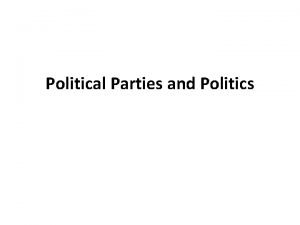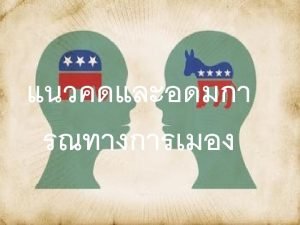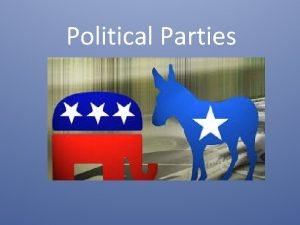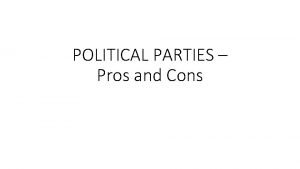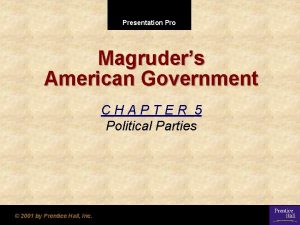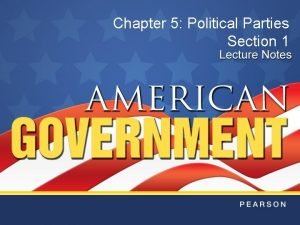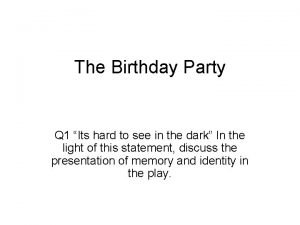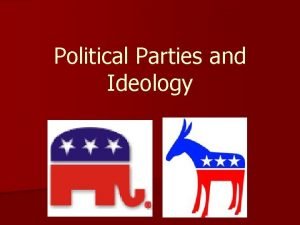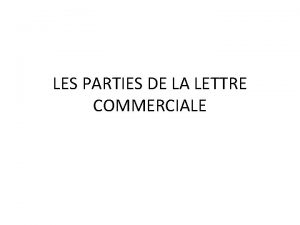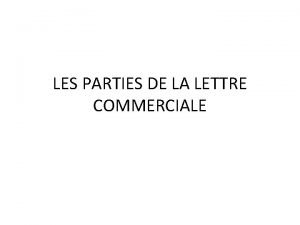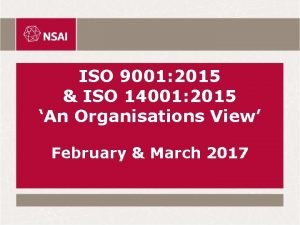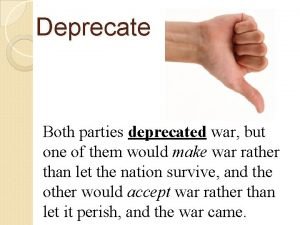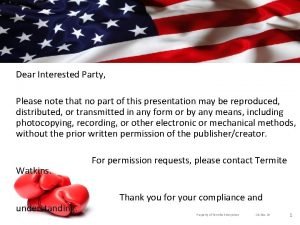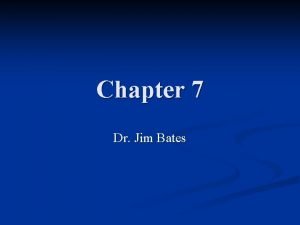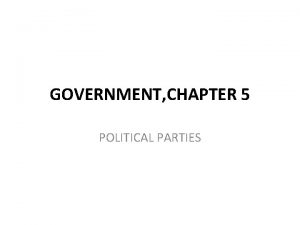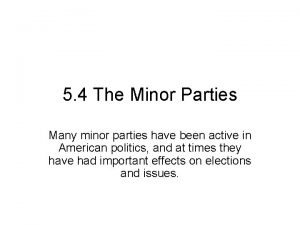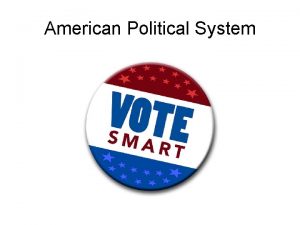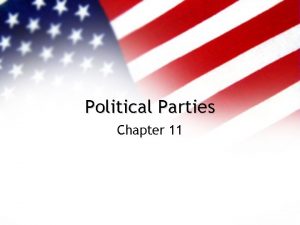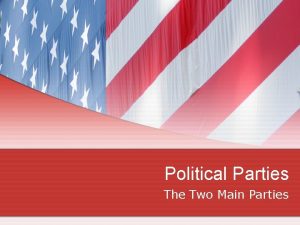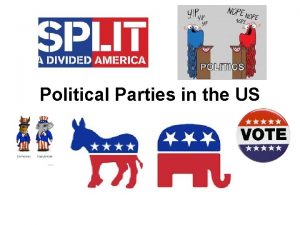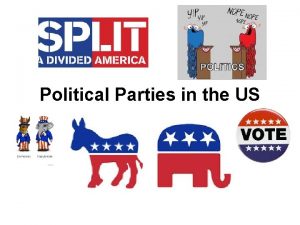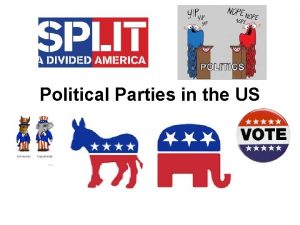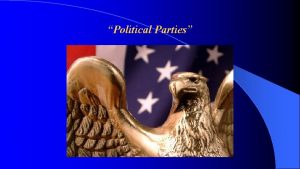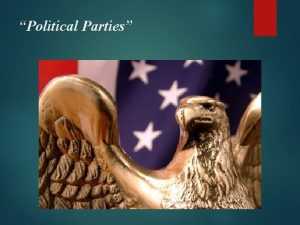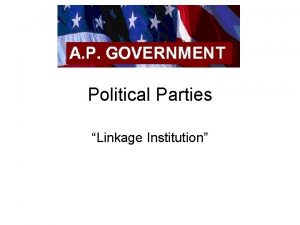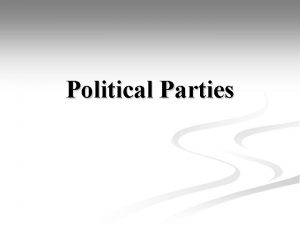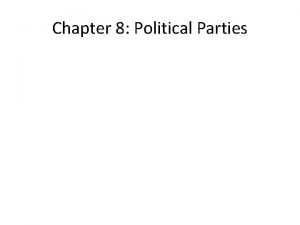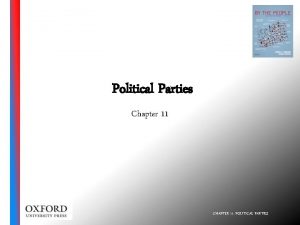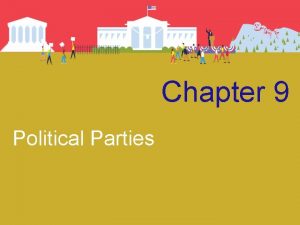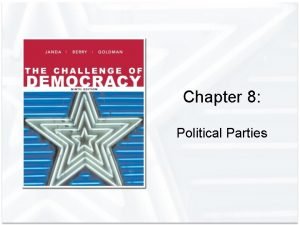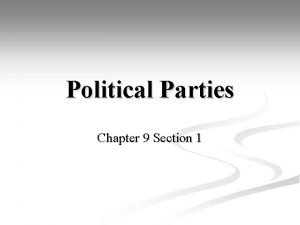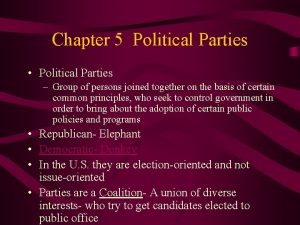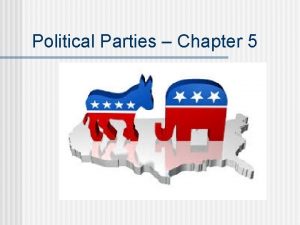Chapter 11 Political Parties To Accompany Comprehensive Alternate

































- Slides: 33

Chapter 11 Political Parties To Accompany Comprehensive, Alternate, and Texas Editions American Government: Roots and Reform, 10 th edition Karen O’Connor and Larry J. Sabato Pearson Education, 2009

Political Parties Organized effort to gain power through elections. Consist of three entities. Governmental party, or the office holders. Organizational party, or the workers and activists. Party in the electorate, or the voters.

Roots of the Party System Federalists and Democratic-Republicans were earliest. 1820 s Era of Good Feelings is relatively party-free. Whigs and Democrats after 1832. Development of the Republican Party in 1854.

Figure 12. 1 - American Party History Back

Twentieth-Century Party System 1876 -1912 was Golden Age of parties due to machines. Parties weakened in the modern era. Development of direct primary system. Changes in civil service laws. Growth of candidate-centered and issue-oriented politics. Increase in ticket-splitting.

Party Realignment During a realignment, party coalitions change. Critical elections put key issues into perspective. 1800, 1860, and 1932 were critical elections. No uniform realignment has occurred since 1932. Political system characterized by secular realignment.

Functions of the Party System Mobilizing support and building coalitions. Encouraging stability in the political system. Providing accountability for public policy. Running candidates for office. Providing a cue for voters. Formulating policy through a national party platform.

Figure 12. 2 - Realigning Elections Back

Table 12. 1 - Party Platforms Back

Minor Parties Winner-take-all system makes it difficult to win office. Sharp contrast to proportional systems used elsewhere. Rooted in sectionalism, protest, issues, and people. Do best when there is little trust in other parties. Can have success in putting issues on agenda.

Party Organization National committees, which hold conventions. State committees. Local committees. Informal groups, such as PACs and think tanks. Changed dramatically in recent years. New rules about soft and hard money have played role.

Figure 12. 3 - Party Organization Back

Figure 12. 4 - Political Party Finances Back

Party in Government Parties play a major role in organizing Congress. Parties shape perceptions of presidents. Presidents--to varying degrees--act as party leaders. Party may predict some judicial decisions.

Figure 12. 5 - Congressional Party Unity Back

Figure 12. 6 - Gender Gap Back

Party in the Electorate Party identification shapes political worldview. May be shaped by demographic characteristics. South, middle-aged, and white-collar more Republican. Evangelicals and married more Republican. Women, minorities, and Jews more Democratic. Unions, advanced degrees, and single more Democratic.

AV- Partisan Identification Back

Table 12. 2 - Party Identification by Group Back

Dealignment and Party Strength Argument that we are in a period of dealignment. Voters are much less likely to identify with a party. Result of the growth in issue-oriented politics. Parties are important in electorate and in government. Parties continue to be competitive with one another.

Chapter 11 Interest Groups To Accompany Comprehensive, Alternate, and Texas Editions American Government: Roots and Reform, 10 th edition Karen O’Connor and Larry J. Sabato Pearson Education, 2009

Interest Group Theory Groups build social capital and civic virtue. Their main goal is to influence public policy. A variety of theories exist about why groups form. Pluralist theory, which is related to disturbance theory. Transactions theory. Neopluralist theory (i. e. population ecology theory).

Types of Organized Interests Public interest groups (i. e. NARAL, NRA). Economic interest groups (i. e. AFL-CIO, NAM). Governmental units, who lobby for earmarks. Political action committees (i. e. EMILY’s List). Multi-issue versus single-issue groups.

AV- Interest Group Ratings Back

Roots of Interest Groups First national groups emerge in 1830 s. Business interests play larger role after Civil War. Groups begin to send lobbyists to Washington Progressive era leads to an explosion of groups. Growth of labor and trade associations.

The Interest Group State Expansion of civil rights and groups in 1960 s. Development of conservative and religious groups. Evolution of new business groups dedicated to lobbying. Declining power of organized labor.

Table 16. 1 - Interest Group Profiles Back

Lobbying Target Congress through research, money, or testimony. Also target bureaucratic agencies and the president. Lobby courts through sponsorship or amicus briefs. Can use grassroots techniques, such as petitions. May also resort to protests and activism.

Table 16. 2 - Lobbying Techniques Back

Election Activities Recruiting and endorsing candidates. Organizing get out the vote efforts. Rating candidates and office holders. Establishing political action committees.

What Makes a Group Successful? Leaders, to inspire membership. Patrons, for funding. Members, who are involved at varying levels. Membership helps to overcome the free rider problem. Particularly true for groups that provide collective goods.

Regulating Interest Groups 1995 Lobbying Disclosure Act regulates Congress. Requires lobbyists to register and report payments. New 2007 Honest Leadership and Open Government Act. Bans gifts, toughens disclosure, increases time limits. Executive regulated by 1978 Ethics in Government Act.

Table 16. 4 - Ethics in Government Act Back
 Accompany chapter 1
Accompany chapter 1 Brainpop voting
Brainpop voting What was one way progressives differed from populists
What was one way progressives differed from populists Political parties
Political parties Political parties
Political parties A political party is an association of
A political party is an association of Soup and ideology
Soup and ideology Political parties
Political parties Political parties pros and cons
Political parties pros and cons Things that accompany salvation
Things that accompany salvation Venous system of upper limb
Venous system of upper limb Inkjet printers are considered legacy technology
Inkjet printers are considered legacy technology 4 types of minor parties
4 types of minor parties Chapter 5 section 1 parties and what they do
Chapter 5 section 1 parties and what they do Chapter 5 section 1 parties and what they do
Chapter 5 section 1 parties and what they do Chapter 3 comprehensive exam
Chapter 3 comprehensive exam The birthday party act 2 summary
The birthday party act 2 summary Self-announcement definition
Self-announcement definition Food themes for parties
Food themes for parties Les parties de la lettre commerciale
Les parties de la lettre commerciale Les parties de la lettre
Les parties de la lettre Partie du corps dauphin
Partie du corps dauphin Iso 14001 risk and opportunities examples
Iso 14001 risk and opportunities examples Both parties deprecated war
Both parties deprecated war Dear interested parties
Dear interested parties Microscope optique
Microscope optique Why does george wilson lock myrtle in the bedroom?
Why does george wilson lock myrtle in the bedroom? Economic protest parties definition
Economic protest parties definition Sarah and pam often go to parties
Sarah and pam often go to parties Les parties du texte narratif
Les parties du texte narratif Accounting information system chapter 1
Accounting information system chapter 1 Economic protest parties definition
Economic protest parties definition Socialist parties
Socialist parties Sujet divisé alloprof
Sujet divisé alloprof





